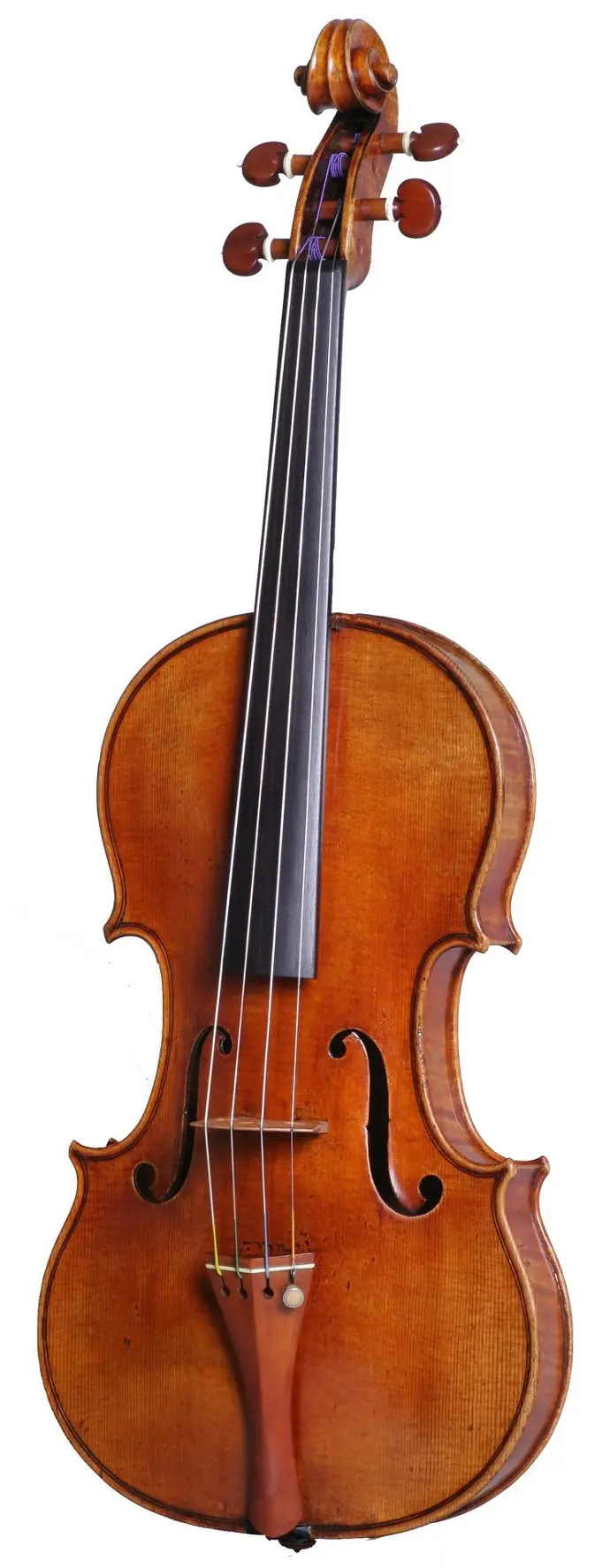The strings of a violin are fundamental in shaping its sound, responsiveness, and overall performance. Choosing the right strings depends on the player’s level, musical style, and the tonal qualities you want to achieve. With reputable brands like Thomastik-Infeld, Pirastro, Larsen, and D'Addario, violinists have a wide range of options for different needs. In this article, we’ll explore the various types of violin strings, how their material impacts sound, string tensions, when to replace strings, and some important considerations to keep in mind.
Types of Violin Strings
There are three primary types of violin strings: gut, synthetic core, and steel core. Each type offers distinct characteristics, and your choice will depend on your desired sound and playing level.
- Gut Strings
- Material: Historically made from sheep or cattle gut, gut strings are often wound with metals like silver or aluminum for durability.
- Sound: Gut strings are known for their warm, complex, and rich tone. They offer a more authentic sound favored by Baroque musicians and classical players seeking depth and nuance.
- Pros: Excellent tonal warmth and depth. They respond well to subtle bow pressure and allow for dynamic expression.
- Cons: Gut strings are sensitive to temperature and humidity, requiring frequent tuning and offering less durability than synthetic or steel core strings.
- Popular Choices: Pirastro Eudoxa and Pirastro Olive are renowned gut strings, providing a rich tonal palette.
- Synthetic Core Strings

- Material: These strings are made from synthetic fibers such as nylon or composite materials, typically wound with metals like silver or aluminum.
- Sound: Designed to emulate the warmth of gut strings, synthetic core strings offer more tuning stability and durability. They provide a well-rounded, full sound that suits a wide range of music genres.
- Pros: Stable tuning, longer-lasting than gut strings, and resistant to climate changes.
- Cons: Though they mimic gut strings, they may lack the complexity and organic warmth of true gut strings.
- Popular Choices: Thomastik-Infeld Dominant strings are the go-to choice for many violinists, offering a balanced, versatile sound. Pirastro Evah Pirazzi and Larsen Tzigane are also popular, known for their projection and power.
- Steel Core Strings
- Material: These strings feature a steel core, typically wound with chrome, silver, or tungsten.
- Sound: Steel core strings produce a bright, clear, and focused sound. Their fast response and clarity make them popular in genres like folk, jazz, and even in some orchestral settings.
- Pros: Highly stable tuning, long-lasting, and provide excellent projection.
- Cons: Some players find steel strings to be harsher in tone, lacking the warmth of synthetic or gut strings.
- Popular Choices: D'Addario Helicore and Jargar steel core strings are widely appreciated for their clarity and durability.
String Tension and Its Impact on Sound
Violin strings are available in different tensions: light (low), medium, and heavy (high). The tension you choose can significantly affect the sound, playability, and feel of your instrument.
- Light Tension (Low) Strings:
- Sound: Light tension strings offer a softer, more delicate tone with more overtones and flexibility. They are often favored by players looking for a more refined, nuanced sound, particularly in classical music.
- Pros: Easier on the fingers and bow, producing a more flexible and sensitive response.
- Cons: Less projection and volume than heavier strings. They may also require more precision with bow control.
- Best For: Players who prioritize warmth, nuance, and subtlety in their playing.
- Medium Tension Strings:
- Sound: Medium tension strings provide a balanced tone, offering a mix of power, projection, and warmth. They are the most versatile and widely used among violinists.
- Pros: A good balance between flexibility and volume, offering more stability across different playing styles.
- Cons: Some players feel medium tension strings lack the distinctive extremes of tone offered by light or heavy strings.
- Best For: All-rounders, including both beginner and advanced players who want a well-rounded, versatile sound.
- Heavy Tension (High) Strings:
- Sound: Heavy tension strings produce a more powerful, focused sound with greater volume. They are ideal for players who need strong projection, especially in orchestral or solo settings.
- Pros: Offer more volume and a thicker, fuller tone. They also require more bow pressure, which can enhance control for advanced players.
- Cons: Can be harder on the fingers and may require more physical effort to play. Heavier tension can also make the instrument feel stiffer and less responsive.
- Best For: Professional or advanced players who need maximum power and projection.

Replacing Violin Strings: When and Why
One of the most common questions among violinists is how often they should change their strings. The lifespan of your strings depends on several factors, including how often you play, your playing style, and the type of strings you use. Here are some general guidelines:
- Gut Strings: Gut strings typically have the shortest lifespan, often needing replacement every 2-3 months for frequent players. Because they are sensitive to temperature and humidity, they can fray and wear out faster.
- Synthetic Core Strings: These tend to last longer than gut strings, usually around 4-6 months for regular players. They offer a good balance between durability and sound quality.
- Steel Core Strings: Known for their durability, steel strings can last 6-12 months or longer, especially if the player isn’t performing daily. However, the tone may become harsh or lose its warmth over time.
Signs that your strings need replacing include:
- Loss of tone: If your strings sound dull, unresponsive, or lack resonance, it's a clear sign they are worn out.
- Fraying or unwinding: Physical damage, such as the winding separating or fraying, indicates that the string is nearing the end of its lifespan.
- Tuning instability: If you find yourself tuning your violin more often than usual, it may be time to change your strings.
String Shelf Life: Do Strings Expire?
While unopened violin strings don’t technically "expire," they can deteriorate if stored improperly. Heat, humidity, and exposure to air can cause the materials to break down over time. It's best to store spare strings in a cool, dry place away from direct sunlight to maintain their quality.
Most string manufacturers recommend using strings within 2-3 years of purchase for optimal performance. While older strings can still be used, their elasticity and tonal properties might diminish with age, especially if they’ve been exposed to unfavorable conditions.
Choosing the Right Strings for Your Playing Level
- Beginner and Intermediate Players:
- Recommended Strings: Beginners benefit from durable, stable strings that stay in tune easily. Steel core strings like D'Addario Prelude or Thomastik-Infeld Alphayue are budget-friendly and dependable options. Intermediate players often move towards synthetic core strings like Dominant, which offer better tonal qualities without sacrificing tuning stability.
- Focus: Prioritize durability, tuning stability, and affordability. These strings are more forgiving and require less frequent maintenance.
- Advanced and Professional Players:

- Recommended Strings: Advanced players often seek strings that maximize their instrument’s tonal potential. Pirastro Evah Pirazzi and Larsen Virtuoso are great synthetic options for power and projection. For those seeking warmth and complexity, Pirastro Olive gut strings are a top choice.
- Focus: Prioritize sound quality, projection, and tone refinement. At this level, the choice of strings becomes more about complementing the specific qualities of your instrument.
Beware of Low-Quality or Unreliable Strings
When purchasing violin strings, it’s crucial to stick to well-known, reputable brands like Thomastik-Infeld, Pirastro, Larsen, and D'Addario. Be cautious of unknown or generic strings sold at very low prices. These strings often lack consistency in sound and durability, and in some cases, they can damage your instrument or significantly reduce its sound quality.
While the low cost might be tempting, poor-quality strings tend to wear out faster and can negatively impact your playing experience. It’s always a better investment to buy strings from trusted manufacturers that guarantee quality and consistency.
String Maintenance: Getting the Most Out of Your Strings
To prolong the life of your strings and maintain optimal sound quality, proper care is essential:
- Clean your strings after each use: Wipe down your strings with a soft cloth after every practice session to remove sweat, rosin, and dirt. Build-up can degrade the string's material and tone.
- Monitor for wear and tear: Check regularly for signs of fraying, unwinding, or loss of tonal clarity.
- Change your strings regularly: Professional players may change their strings every few months, while beginners and hobbyists might need to replace them once or twice a year.
Conclusion: The Importance of Choosing the Right Strings
The strings on your violin are the heart of its sound. Whether you're a beginner needing reliable tuning or a professional seeking the perfect tone, choosing the right strings is crucial for unlocking the full potential of your instrument. Sticking with trusted brands like Thomastik-Infeld, Pirastro, Larsen, and D'Addario ensures you get strings that offer consistency, durability, and excellent sound.
Remember, the best strings for your violin are the ones that suit your instrument and your style of playing. It’s worth experimenting with different types, tensions, and brands to find the perfect match, but always prioritize quality over cost to keep your violin sounding its best.


Strings and Sound: How Different String Types Affect the Violin